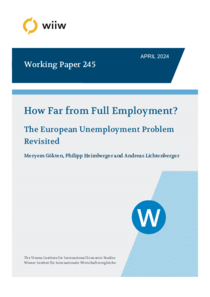How Far from Full Employment? The European Unemployment Problem Revisited

Gökten, Meryem ; Heimberger, Philipp ; Lichtenberger, Andreas
Vienna Institute for International Economic Studies
WIIW - Vienna
2024
41 p.
full employment ; unemployment
Working Paper
245
Employment
English
Bibliogr.
"This paper analyses deviations from full employment in EU countries, compared with the US and the UK. We apply the Beveridge (full-employment-consistent) rate of unemployment (BECRU), derived from the unemployment-vacancies relationship. The BECRU is the level of unemployment that minimises the non-productive use of labour. Based on a novel dataset for the period 1970-2022, we find full employment episodes in selected EU countries (Germany, Sweden, Austria, Finland) during the 1970s. The European unemployment problem emerged in the 1980s and 1990s, as Beveridgean full employment gaps increased. In the run-up to the global financial crisis, full employment gaps declined, then increased during the Great Recession. Slack in labour markets increased initially during the pandemic. Labour markets became tighter when recovering from the COVID-19 crisis, but few countries hit full employment. Panel regressions highlight that hysteresis, labour market institutions, structural factors, macroeconomic factors and political factors contribute to explaining full employment gaps."
Digital
The ETUI is co-funded by the European Union. Views and opinions expressed are however those of the author(s) only and do not necessarily reflect those of the European Union or the ETUI.